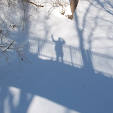Jasper-Pulaski Fish & Wildlife Area is dedicated to providing quality hunting and fishing opportunities while maintaining 8,062 acres of wetland, upland and woodland game habitat. Jasper-Pulaski's suitable habitat provides an ideal stopover for migratory bird. More than 10,000 sandhill cranes stop during fall migration.It also says that land acquisition began in 1929. During the 1930s it was designated as a game farm and game preserve. Hunting began in 1958, and it was designated a fish and game area in 1965. Finally in 1972 its name was changed to a fish and wildlife area. It main purpose over time seems to have been to preserve animals so hunters can kill them. However, that may be appropriate because almost all the funds used to create the area and to maintain it comes from hunters and fishermen.
Friday, January 29, 2010
Marsh Trail @ Jasper-Pulaski
The brochure that you can obtain when you stop at the Jasper-Pulaski Fish and Wildlife Area visitors' center states:
Though the Area has over 8000 acres, there are not a lot of places designated for hiking. One of the few is Marsh Observation Trail that starts about a mile north of the sandhill crane observation area.
Hikers and hunters do not mix well. It should not be a surprise that there are few hiking trails.
On the late afternoon that I was there, the pools of water along the road were reflecting the trees like a mirror.
Though the Marsh Trail is more a road than a trail, it is very scenic.
In addition to this trail and the hunting area, Jasper-Pulaski has a tree nursery, an archery range, and a shooting range. I recall that at one time it also raised pheasants, which were released in various places for hunters. I have never seen wild pheasants in Indiana (they were common in southwestern Minnesota when I was a kid), but some people who hunt tell me that there are places in Indiana where they have become established. (They are not a native bird.) I am not sure if the tree nursery and the Tefft Savannah Nature Preserve are included as part of the 8000 acres of the reserve or not.
When you get close to the platform, you are told to stop following the road.
The trail ends at a viewing platform.
The road continues, but it is probably only used by the staff. Below is the platform from the other end.
I would have expected that the sandhill cranes would roost in shallow water. However, I have never seen cranes in this water. In fact, I have never seen many birds at all here.
The sun was getting ready to set, and the photograph below shows a small island that is a bit hard to see well because the light is almost behind it.
My daughter-in-law had a much better camera than I have, and she was able to get a decent picture of a heron that was far enough away that our presence did not bother it.
Behind us we could see our shadows as we stood on the platform.
The sun was setting, so it was time to head back to the sandhill crane viewing area. What we saw there was reported here.
By the way, the Jasper-Pulaski Fish and Wildlife Area also includes a bit of Starke County. Maybe it should be the Jasper-Pulaski-Starke Fish and Wildlife Area.
Subscribe to:
Post Comments (Atom)















1 comment:
The cranes fly into the marsh around sunset in October, November and December. They gather at the other field, then head to the marsh. I stayed late enough one day in Nov. a couple years ago to see 1,000 or more.
Thanks for some nice photos and a great write-up.
Post a Comment